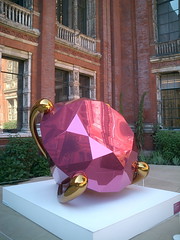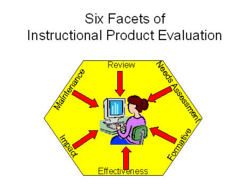Image: Diagram from a presentation by Professor Tom Reeves
Your explorations of the evaluation tasters and the Evaluate This exercise have hopefully helped you to understand that there are different reasons for doing evaluation. The evaluation type or method you choose for your project will depend on why you are doing the evaluation. During this topic over the next week, you will be investigating both formative and summative evaluation methods such as: needs analysis, usability, effectiveness, impact and maintenance evaluation. These methods are outlined in one of this week's activities - the presentation by Professor Tom Reeves - it depicts "Six Facets of Instructional Product Evaluation. Review. Effectiveness. Maintenance. Formative. Needs Assessment. Impact. Development Activities". - The presentation is based on the book by Reeves, Thomas, C. and John G. Hedberg (2003), Google Books, 2008 Interactive Learning Systems Evaluation (click preview to view chapters), Englewood Cliffs: Educational Technology Publications - available in the Manukau Institute of Technology library. You can request a copy of one chapter to be emailed as well.
 |
| Diamond (Pink) by Clagnut |
If the broader evaluation method, that is, whether it is formative or summative is discussed and planned thoroughly, very useful information can be obtained. If you are clear about the phase of eLearning to be evaluated, the method to be used will become clear. For example, if eLearning is in the early planning stages, a needs analysis will be appropriate. However, if an eLearning course or resource has already been developed and has been launched as a finished product, then an effectiveness evaluation is more relevant.
As you have probably already realised since viewing the presentation - Why is evaluation so important? - evaluation is an ongoing process from the ideas phase right through design, development and implementation. This concept is reiterated in this week's topic with a more detailed explanation about evaluation and the ADDIE model on an audio I have made. There are lots of activities this week, and they are listed in the Methods section of the course wiki. They will prepare you for the next phase - planning your evaluation project so buckle yourself in for the ride.
First of all though - would you eat these pizzas? Watch and decide for yourself.


4 comments:
First up - let me be clear, I do not eat bought pizza - not my favourite food so I have never tried a Domino one. What I did learn during my time living in the States a couple of years ago and visiting there over the last 18 years is that a lot of the food is tasteless IMHO. And as I watched Americans of all ages - including my grandchildren- literally pour ketchup and mustard and other "stuff" all over their food so that is unrecognisable I concluded (made an evaluation!) that it is the sauces and condiments that tickle the palate of many Americans.They needed to disguise the blandness of the food. I admit this is a gross exaggeration in reaction to some footage of gross pizzas. But...
Having been shopping with Pizza planned for dinner this week I am glad I make my own even down to the sauce.
At one point I checked the date of this item at one point you could believe that it is April the 1st.
Hi,
I agree with you Katie, is this real?
Having said that, I used to teach product development in a past life and our students would come up with some strange concepts around creating a new product for Marks and Spencers.
Don't even ask about the evaluation sheets we used to have when judging the sausage competitions!
All based around organoleptic testing of course!
http://tiny.cc/ztyn0
That’s rich, a Kiwi criticizing the American diet, apparently you just arrived here :-). If there isn’t a kilo of sugar on pizza here its called “bland”. You cannot get real Italian pizza here, Kiwi “pizza”, sure. The Kiwi palate for pizza is all about the sugar, you don’t find most of the popular pizza choices here anywhere else in the world, there’re more a dessert than a meal. Next time you’re in North America I’ll give you some address’s for some real “za” experiences. Forgive my testiness, I’ve been jonesing for a real slice for years. :-)
Post a Comment